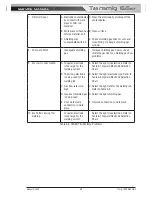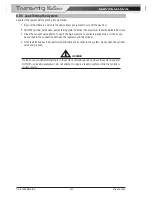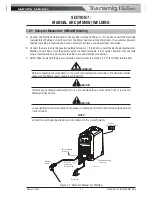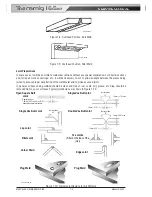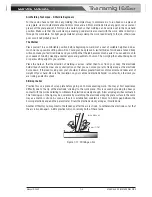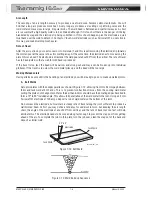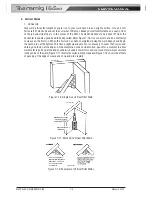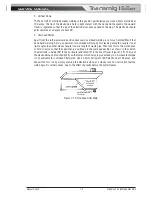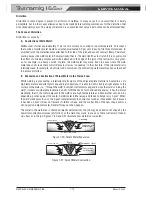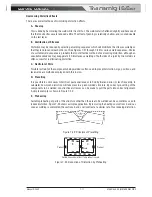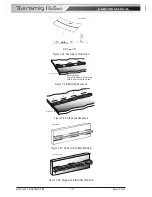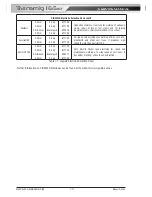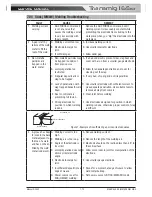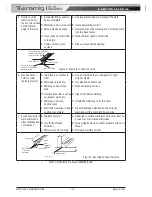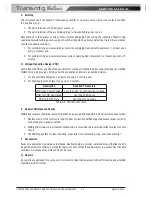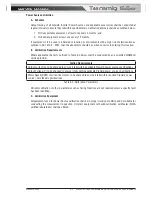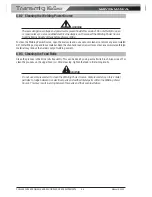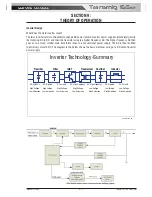
MANUAL ARC (MMAW) WELDING 7-6 Manual 0-5442
SERVICE MANUAL
Transmig 165
ST
Transmig 165
ST
SERVICE MANUAL
Transmig 165
ST
Transmig 165
ST
Arc Length
The securing of an arc length necessary to produce a neat weld soon becomes almost automatic. You will
find that a long arc produces more heat. A very long arc produces a crackling or spluttering noise and the
weld metal comes across in large, irregular blobs. The weld bead is flattened and spatter increases. A short
arc is essential if a high quality weld is to be obtained although if it is too short there is the danger of it being
blanketed by slag and the electrode tip being solidified in. If this should happen, give the electrode a quick
twist back over the weld to detach it. Contact or "touch-weld" electrodes such as Ferrocraft 21 do not stick in
this way, and make welding much easier.
Rate of Travel
After the arc is struck, your next concern is to maintain it, and this requires moving the electrode tip towards
the molten pool at the same rate as it is melting away. At the same time, the electrode has to move along the
plate to form a bead. The electrode is directed at the weld pool at about 20º from the vertical. The rate of travel
has to be adjusted so that a well-formed bead is produced.
If the travel is too fast, the bead will be narrow and strung out and may even be broken up into individual
globules. If the travel is too slow, the weld metal piles up and the bead will be too large.
Making Welded Joints
Having attained some skill in the handling of an electrode, you will be ready to go on to make up welded joints.
A. Butt Welds
Set up two plates with their edges parallel, as shown in Figure 7-12, allowing 1.6mm to 2.4mm gap between
them and tack weld at both ends. This is to prevent contraction stresses from the cooling weld metal
pulling the plates out of alignment. Plates thicker than 6.0mm should have their mating edges bevelled to
form a 70º to 90º included angle. This allows full penetration of the weld metal to the root. Using a 3.2mm
Ferrocraft 21 electrode at 100 amps, deposit a run of weld metal on the bottom of the joint.
Do not weave the electrode, but maintain a steady rate of travel along the joint sufficient to produce a
well-formed bead. At first you may notice a tendency for undercut to form, but keeping the arc length
short, the angle of the electrode at about 20º from vertical, and the rate of travel not too fast, will help
eliminate this. The electrode needs to be moved along fast enough to prevent the slag pool from getting
ahead of the arc. To complete the joint in thin plate, turn the job over, clean the slag out of the back and
deposit a similar weld.
Art # A-07697_AB
Tack Weld
20°-30°
Electrode
Tack Weld
Figure 7-12: Butt Weld
Art # A-07698
Figure 7-13: Weld Build up Sequence
Содержание Transmig 165ST
Страница 16: ...SERVICE MANUAL Transmig 165ST Transmig 165ST GENERAL INFORMATION 1 10 Manual 0 5442 Notes ...
Страница 32: ...OPERATION 4 6 Manual 0 5442 SERVICE MANUAL Transmig 165ST Transmig 165ST Notes ...
Страница 84: ...SERVICE MANUAL Transmig 165ST Transmig 165ST THEORY OF OPERATION 9 2 Manual 0 5442 Notes ...
Страница 115: ...SERVICE MANUAL Transmig 165ST Transmig 165ST Manual 0 5442 12 3 ASSEMBLY PROCEDURE 8 7 A 10011 9 A 10012 ...
Страница 118: ...SERVICE MANUAL Transmig 165ST Transmig 165ST ASSEMBLY PROCEDURE 12 6 Manual 0 5442 14 Art A 13011 ...
Страница 120: ...SERVICE MANUAL Transmig 165ST Transmig 165ST ASSEMBLY PROCEDURE 12 8 Manual 0 5442 Notes ...
Страница 125: ...SERVICE MANUAL Transmig 165ST Transmig 165ST This Page Intentionally Blank ...








